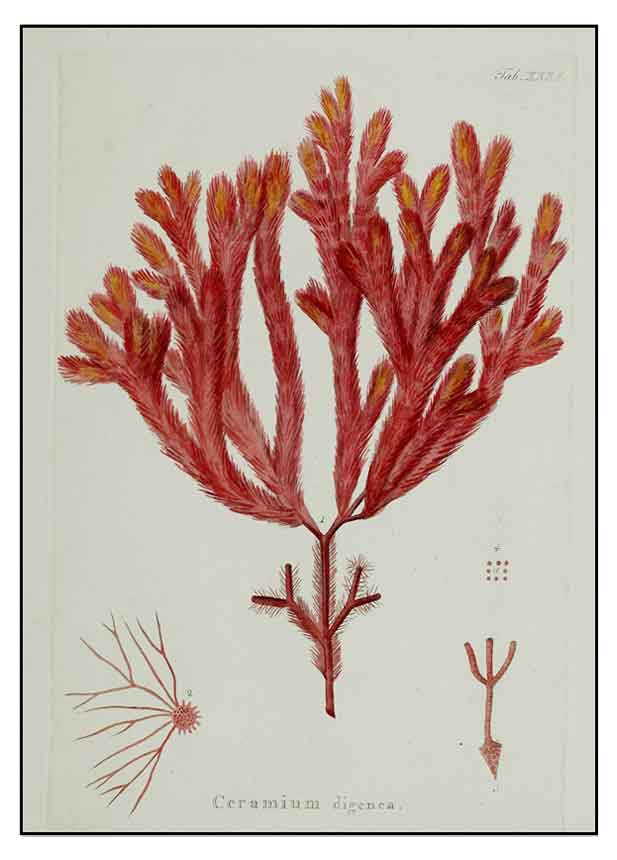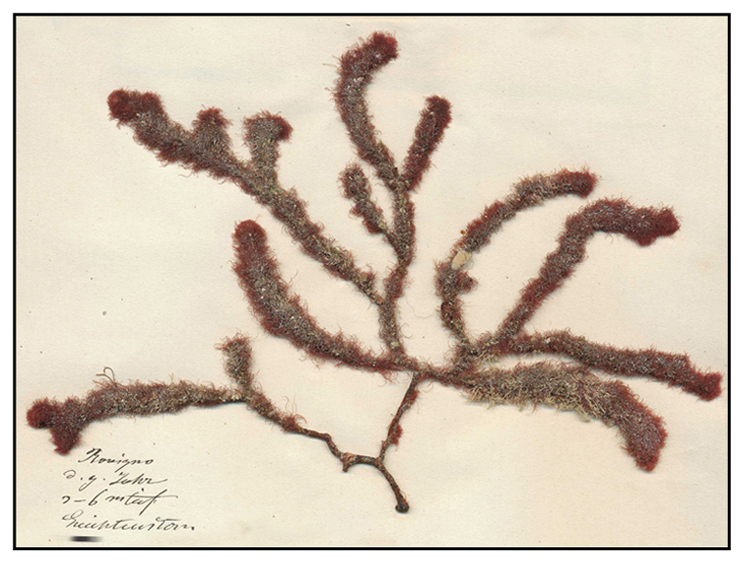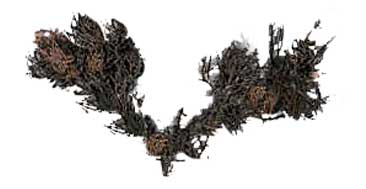 Gen info Gen info
- For more than 1000 years, two Japanese red algae, Digenea simplex and Chondria armata, have been used in Japan as potent anthelmintics, for eliminating intestinal worms such as parasitic roundworms (Ascaris lumbricoides), whipworms (Trichuris trichura) and tapeworms ( Taenia spp.). Two closely related compounds isolated from these red algae, kainic acid and domoic acid, are responsible for these anthelmintic effects. (8)
- Etymology: The species name simplex derives from Latin, meaning simple, undivided, unbranched, of one piece or series, not consisting of several distinct parts (Stearn 1973).
- The local name Gulaman inpupurga means "vermifuge seaweed".
Botany
• Kai-jin-so is a red alga, 5 to 10 centimeters long with rounded thallus, the branching irregular and dichotomous. Upper part of the plant is clothed with slender but stiff polysiphonous rumelli and often overgrown with various epiphytic algae. Color is purplish red turning greenish or grayish upon drying.
• Thalli erect, dull brownish red. Branches densely clothed with hair-like determinate branchlets, especially at the upper half portion of the thallus. Branching of the main axis basically dichotomous but may become irregular due to the production of adventitious laterals. Determinate branchlets uncorticated and consisting of a distinct axial cell surrounded by nine pericentral cells. Thalli up to 9 cm in height. (21)
Distribution
-
Common in the Batanes Islands, the east coast of Luzon and in Palawan
- Reported in Indonesia and Papua New Guinea.
.
- The seaweed grows chiefly on rocks or coral chips at a depth of 1.5 to 7 meters below the water level. Surface growth is not very abundant.
- Also reported in the southern part of Taiwan, the West Indies, in the Ryuku, in the southern part of Kyushu Island in Japan, and the Pratas Island in China.
 Constituents Constituents
- Active principle as been identified as kainic acid.
- L-a-kainic acid has a structure of Ls-arabo-2-carboxy-3-carboxymethyl-4-isoisopropenylpyrrolidine. (9)
- In Japan, kainic acid is derived from the seaweed, sold commercially as anthelmintic.
- Contains a kind of mucilage similar to agar-agar and related to arabin.
- In Japan, alga extract is called macnin.
- A Chinese study yielded algenic acid, a small amount of unidentified alkaloid, galactan, fucoidin and iodine.
- Study yielded sugar, uronic acids, sulfate, betaines, amino acids.
- An aqueous extract isolated seven Dragendorff-positive compounds. Two metabolites were assigned structures (R)-3-dimethylsulfonio-2-methoxypropanoate and (S)-2-acetamido-5-trimethylammoniopentanoate.
(7)
- Contains agar (10-15% of dry weight) and kainic acids. Of these, α-kainic acid is said to be anthelmintic, ten times stronger than santonin, a compound of the salt marsh plant Artemisia maritima. Another anthelmintic from Digenea simplex, α-allokainic acid, is only slightly effective. (10)
- Mineral composition (mg/100 mgDW) yielded sodium 1198±1.15, calcium 432±0.58, phosphorus 368±0.4, magnesium 398±.58, potassium 7744±1.40, lead 0.01±0.01, Na/K ratio0.15±0.03. (12)
- Amino acid composition (g/100g sample dry basis) yielded total non essential amino acids of 28.52 (alanine, arginine, aspartic, cyst4eine, glutamic, glycine, proline, serine, tyrosine) and a total of essential amino acids of 40.78 ( histidine, isoleuciine, leucine, lysine, methionine, phenylalanine, threonine, valine, tryptophan). (12)
 - Study isolated digenic acid and digeneaside from Digenea simplex. The acid was found to have anthelmintic action. (19) - Study isolated digenic acid and digeneaside from Digenea simplex. The acid was found to have anthelmintic action. (19)
- Nutrient composition yields 42.4% carbohydrate, 21.14% protein, and 2.3% lipid. Fiber content (g/100 wet weight) yields total fiber 10.55g, soluble fiber 7.98, and insoluble fiber 2.57. Mineral composition (mg/100g DW) yields sodium 1198, calcium 432, phosphorus 368, magnesium 398, potassium 7744, lead 0.01, Na/K ratio 0.15.
(25)
-
Fatty acid contents (mg/g sample) and profiles (g/100 g fatty acids) yielded: Saturated fatty acids: caprylic 2.154, pelargonic 1.02, capric 2.24, lauric 4.01, tetradecanoic 1.99, myristic 1.76, palmitic 14.02, stearic 1.83, arachidic 30.78 (total 59.81: 65.05% of total FA); Mono-unsaturated (MUFA): myristoleic 3.70, palmitoleic 6.50, petroselinic 4.74, oleic 0.320, eicosanoate ND (total 15.26: % total FA 16.60); Polyunsaturated (PUFA): linoleic 6.52, linolenic 2.80, arachidonic 2.90, eicosapentaenoic 3.20 (total 15.42: 16% of TFA) - TFA 91.94.
(25)
- Amino acid composition (g/100 g sample dry basis): Non-Essential amino acids: alanine 2.40, arginine 2.34, aspartic 5.01, cysteine 1.88, glutamic 7.50, glycine 1.87, proline 0.320, serine 2.80, tyrosine 4.40 (total 28.52); Essential amino acids: Histidine
0.86, 1.79, leucine 5.70, lysine 6.50, methionine 4.87, phenylalanine 10.74, threonine 7.52, valine 1.80, tryptophan ND (total 40.78) - total amino acids 70.30.
(25)
 Properties Properties
- Seaweed grows chiefly on rocks or coral chips at depth of 1.5 to 7 meters below water level.
-
Surface growth is not very abundant.
- Non toxic.
- Studies have suggest anthelmintic, antioxidant, antimicrobial
,
antifungal, anti-inflammatory, antinociceptive, antiviral, nutrient, antimelanogenesis, wound healing properties.
Parts used
Whole plant.
Uses
Edibility
- An edible seaweed. (see nutrient content above)
Folkloric
- No reported folkloric medicinal use in the Philippines.
-
In China, used as both anthelmintic and as laxative for infants supposed to be infected with "womb poison."
- Used in the treatment of Ascaris and Oxyuris.
- In Japanese folk medicine, use to rid the body of intestinal worms.
- Helminal, according to the United States Dispensatory, is an extract derived from Digenea simplex.
Studies
• Chemical Composition / Antioxidant Activities: Study of three algal samples, including Digenea simplex, yielded sugars, uronic acids, sulfate, amino acids and small amounts of betaines. All three algal extracts showed antioxidant activities on lipoxygenase, DPPH and Ames testing.
• Kainic Acid: In 1953, an excitotoxic amino acid, kainic acid, was isolated from the seaweed, Kainin-sou (Makuri) in Japan. Kainin-sou has been used as anthelmintic in Japan. Kainic acid is a potent CNS stimulant, a prototype neuroexcitatory amino acid acting on specific kainate receptors, used for seizure induction in experimental animals. (4) Laboratory animals dosed with kainic acid developed seizures. This led to the discovery of AMPA-kainate receptors on motor neurons
• Celecoxib in Rat Brain after KA Administration: Kainic acid (Kainate, KA) is a minor amino acid found in Digenea simplex seaweed. Subcutaneous injection in rat induced limbic seizures. The KA-induced seizures in rat provide a model of centrally mediated, high level COX-2 induction. Study showed kainate's profound excitotoxic stimulus elicits selective high level production of PGE2 and PGF2a in the brain, accompanied by high level expression of COX-2 and PGE synthetase -- providing a model for evaluation of pharmacologic activity of inhibitors of enzymes in the PG biosynthetic pathway. (5)
• Anti-Inflammatory and Antinociceptive Polysaccharides: Study investigated the anti-inflammatory and antinociceptive activities of polysaccharide (PLS) fraction isolated from marine red algae Digenea simplex. Results showed dose-dependent reduction of carrageenan-induced edema, and inhibition of inflammation induced by dextran, histamine, serotonin, and bradykinin. The fraction inhibited neutrophil migration into both mouse paw and peritoneal cavity. Findings conclude PLS possess anti-inflammatory and antinociceptive activities and has a potential as an agent against inflammatory diseases. (6)
• Antimicrobial / Anti-Inflammatory: Study evaluated the antimicrobial activity of crude extracts of two species of marine red algae, Acanthophora spicifera and Digenea simplex against human pathogenic bacteria including 10 gram-positive, 10 gram-negative, and ten filamentous fungi using agar well diffusion method. Anti-inflammatory effect of the crude extract on inflamed liver cells was evaluated by measuring SOD, MDA, GSH, IL-6 and TNF-alpha in Wistar albino rats. Both species of marine algae showed highest zone of inhibition against Streptococcus agalactiae, gram-negative Acanthophra spicifera and Pseudomonas aeruginosa. Digenea simplex showed maximum ZOI against Serratia marcescens. Both showed high ZOI against Geotricum candidum. All methanol extracts showed equally potent anti-inflammatory activity as evidenced by measured parameters relatively equal to normal control results. (11)
• Silver Nanopartifcles / Antifungal: Study reports on the biosynthesis of silver nanoparticles using the extracellular filtrate of the algae Digenea simplex. Further studies showed antifungal activity and potential biomedical application. (13)
• Anti-Inflammatory in Induced Colitis / Sulfated Polysaccharides: Sulfated polysaccharides from seaweeds have important biological activities. Study evaluated the anti-inflammatory effect of sulfated polysacchardie extracted from seaweed D. simplex on 2,4,6-trinitrobenzene sulfonic acid-induced colitis in rats. The polysacchardie, composed of ß-d-galactose and 3,6-α-l-anhydrogalactose residues, reduced weight gain and macroscopic and microscopic lesion scores. It also reduced myeloperoxidase activity, reduced proinflammatory cytokines, malondialdehyde, and nitrate/nitrite levels, and preserved glutathione consumption in the colon. Results suggested an anti-inflammatory effect on induced-colitis in vivo. (14)
• Anti-Inflammatory / Antinociceptive / Polysaccharides: Study evaluated the anti-inflammatory and antinociceptive activities of PLS fraction isolated from marine red alga Digenea simplex. The PLS fraction reduced carrageenan-induced edema in a dose dependent manner, and inhibited inflammation induced by dextran, histamine, serotonin, and bradykinin. The fraction inhibited neutrophil migration into both mouse paw and peritoneal cavity. The effect was accompanied by decreases in IL-1ß and TNF-α levels in peritoneal fluid. Pretreatment with PLS at 60 mg/kg significantly reduced acetic acid-induced abdominal writhing, and reduced total licking time in both phase of formalin test, and increased latency in hot plate test. Results suggest anti-inflammatory and antinociceptive effects with potential for use as therapeutic agents against inflammatory diseases. (16)
• Anti-Viral / Inhibition of Cytopathic Activity of HIV-1 and Antigen Production: Study of crude water extract (NS-1) from seaweed (Digenea simplex) exhibited anti-human immunodeficiency virus (HIV-1) activity in vitro. NS-1 inhibited both the cytopathic effect of HIV-1 to MT-4 cells and the giant cell formation of Molt-4 cells infected with HIV-1. (17)
• Treatment and Prevention of Inflammatory Bowel Disease / Polysaccharides / Review: Inflammatory bowel disease (IBD) is a serious worldwide public health problem. Review indicates seaweed extracts and polysaccharides (PLS) are effective candidates for the development of drugs, biological food additives, and functional nutrition products for the prevention and treatment of IBD. The structural features of algal PLS provide the possibility of exposure to therapeutic targets of IBD, including proinflammatory cytokines, chemokines, adhesion molecules, nuclear factor NF-kB, intestinal epithelial cells, reactive oxygen and nitrogen. (18)
• Digenic Acid / Anthelmintic: Study isolated digenic acid and digeneaside from Digenea simplex. The acid was found to have anthelmintic action. (19)
• Nanoparticles / Antioxidant / Anti-Inflammatory / Wound Healing: Study reports on the synthesis of zinc oxide nanoparticles (ZnONPs), gold nanoparticles (AuNPs), and bimetallic nanoparticles (BMNPs) and evaluated polysaccharides (PS) and NPs for antioxidant, anti-inflammatory, and wound healing properties. The PS, Zn-, Au- and BMNOs showed good percentage of ABTS and DPPH radical scavenging activity. BMNPs and ZnONPs showed greater anti-inflammatory properties than AuNPs. On wound healing study, the BMNPs showed maximum percentage reduction of 81.87%. (20)
• In the News: Alternative Production of Kainic Acid: Study reports on a new way to produce kainic acid, a natural seaweed neurochemical and powerful reagent used in brain research. Kainic acid activates excitatory glutamate receptors that control cell-to-cell communication in the brain and are critical for short-term memory. Kainic acid has been used as research tool in studies of human neurological conditions such as epilepsy and Alzheimer's disease. Study published April 17 in the Journal Angewandte Chemie International Edition, reported on the sequencing of the genome of the seaweed known to produce kainic acid, and identified the enzymes responsible for production of the natural chemical. They also utilized a biotechnology to developed a cheaper and more efficient way to produce the seaweed chemical in gram quantities in the lab -- a breakthrough with potential for large-scale production of kainic acid in the future. The biotransformation approach allows for a quicker, cheaper, and more environmental friendly production of kainic acid than traditional chemical synthesis. (22)
• Enhancement of Cytotoxic and Antioxidant Activities by Nanosuspension Technique: Study evaluated the use of a chloroform extract (CHlE) of D. simplex nanosuspension (ChlE-NS) formulation to increase aqueous solubility and bioactivity. On antioxidant assays using DPPH and ABTS, ChlE-NS showed IC50s of 36.86 and 63.5% while ChlE showed 39.90 and 86.5%. The ChlE-NS showed greater cytotoxic activity against four cancer cell lines tested. Results suggest the D. simplex ChlE-NS may be an effective strategy for enhancing ChlE's cytotoxic and antioxidant activities. (23)
• Antimelanogenesis / Skin Whitening Potential: Tyrosinase is a key enzyme in melanin production. Study evaluated the in-vitro anti-tyrosinase and in-vivo anti-melanogenesis activities of some selected red macroalgae of the Persian Gulf. The effects of 100, 250 and 500 µg/mL doses of methanol extracts of three red macroalgae i.e., Digenea simplex, Laurencia papillosa, and Laurencia paniculata. All tested macroalgae showed significantly lower inhibitory effect on activities of diphenolase and monophenolase (of mushroom tyrosinase) compared to kojic acid. D. simplex exhibited most inhibitory effect on mushroom tyrosinase compared to other tested seaweeds and inhibited melanogenesis and tyrosinase activity of zebrafish comparable to kojic acid. Results suggest D. simplex has high potential as whitening agent for use in cosmetics and medicinal formulations to prevent and treat hyperpigmentation diseases. (24)
• Excitatory Amino Acid as Cause of Nodding Syndrome: Nodding syndrome (NS) is a type of epilepsy, a progressive disease characterized by nodding symptoms in children in sub-Saharan Africa. The cause and cure of NS remain unknown. The kainic acid-induced model in experimental animals is a well known epilepsy model used for studying human diseases. Study evaluated the similarities of clinical symptoms and histological changes between NS patients and kainic acid-treated rats. Kainic acid-induced epileptic symptoms were observed in Sprague-Dawley rats, including nodding accompanied by drooling and bilateral neuronal cell death, an increase in tau protein expression, and gliosis found immunohisto-chemically. Symptoms and brain histology were similar in NS and kainic acid-induced rat models. Results suggest kainic acid agonist may be one of the causative substances for NS. The possibility with the excitatory amino acids as kainic acid and the high permeability of the blood-brain-barrier (BBB) should be studied further. (26)
Availability
- Wild-crafted.
- Dried and sold in Japanese and Chinese apothecaries.
- Tablets and extracts in the cybermarket.
|

![]()



 Gen info
Gen info

 Properties
Properties